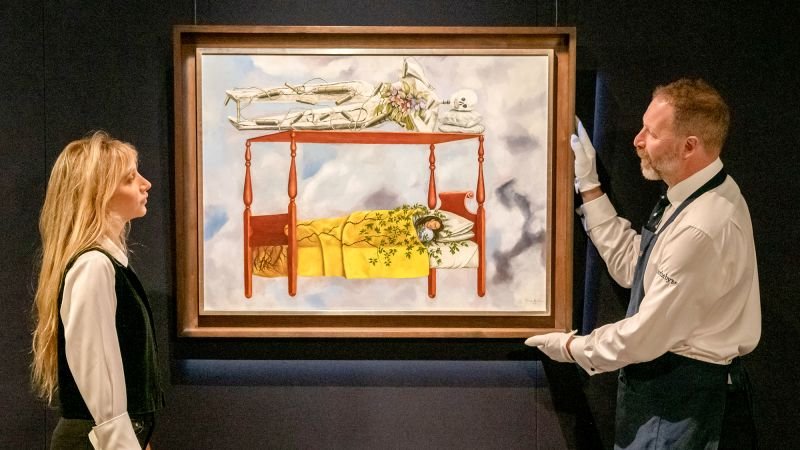A self-portrait by Mexican artist Frida Kahlo is expected to break records when it goes up for auction in New York this week.
The surrealist painting, being sold on November 20 by a private collector, is generating a frenzy of excitement, with experts predicting it could become the most expensive work by a female artist ever sold. That record is currently held by Georgia O’Keeffe’s 1932 painting “Jimson Weed/White Flower No.1,” which fetched $44.4 million in 2014.
Auctioneers at Sotheby’s have valued “El sueño (La cama)” — “The Dream (The Bed)” — at between $40 and $60 million. Kahlo, who died in 1954, already holds the second-highest auction record for a female artist. “Diego y yo” (“Diego and I”), a self-portrait from 1949, featuring her husband, the artist Diego Rivera, fetched $34.9 million in 2021.
While these are hefty price tags, they are dwarfed by the equivalent for works by men. Even if Kahlo’s painting hits the upper valuation, it will be just a fraction of the male record. Leonardo da Vinci’s “Salvator Mundi” sold for an astounding $450.3 million at Christies in 2017.
The gender gap is not limited to dead artists. Earlier this year, South African Marlene Dumas — who only last week became the first contemporary female artist to join the Louvre’s permanent collection — set a record for the highest amount paid for a living female artist. “Miss January,” a large-scale portrait of a semi-nude woman, sold for $13.6 million in May, topping Jenny Saville’s “Propped,” which sold for $12.4 million in 2018. Dumas’ record is not even 15% of the current record for a work by a living male artist – Jeff Koons’ “Rabbit” sculpture, which sold for just north of $91 million in 2019.
So what is behind this massive disparity? Experts believe misogyny, ageism and male-dominated auction houses and museums are factors influencing how art by women is valued.

A 2021 study highlighted a stark gender bias in how society perceives art. Renée B. Adams, a professor of finance at the University of Oxford’s Saïd Business School, was the lead author of “Gendered Prices,” published in The Review of Financial Studies that year.
The researchers showed two groups of participants an identical series of AI-generated artworks and asked them to rate them. One group was shown the works with a male artist’s signature, while others saw the attribution as female. The works supposedly signed by a man were rated higher by regular gallery-goers than those apparently done by a woman.
Adams is currently studying secret postcard auctions, where the artist is supposedly anonymous. “Sometimes, in order to attract people to bid on these postcards, they get very famous artists to participate,” she said, adding that in those cases an artist’s identity can often be inferred from their style.
“If buyers can’t infer identity, there’s no gender difference in price, but as soon as they think they know who the person is, there’s a gender difference in price.”
Adams said the “magnitude” of the gap in the art world stands out from other sectors. “The art market blows all the gender wage gap numbers out of the water,” she said.
“The discount in art prices is not driven by merit, but by factors related to societal perceptions of women. It has nothing to do with whether the painting is good or bad.”
As part of her research for her 2020 book “Women Can’t Paint,” artist, writer and art historian Helen Gørrill took a forensic approach to auctioned art.
“I created a spreadsheet of 5,000 paintings on the secondary market, so at big auctions like Sotheby’s, Christie’s, Phillips,” she told CNN.
This led to a startling discovery. Art signed by a man went up in value compared to unsigned work, and women’s artwork actually went down in value when signed, she told CNN.
She believes the art establishment highlights the success of artists like Saville, Kahlo, Bridget Riley and Yayoi Kusama to suggest progress.
“The ones that are doing really well are being bandied up as an example of how well women are doing, but when you analyze it, we’re not at all,” she said. “In the ’90s, we had far more women succeeding. Now the success is being shared by far fewer women, but on a greater scale,” she said.

Gørrill is currently working on two more books on the subject and said her latest research is no less alarming. Gørrill spoke to artists who were dismissed after having a baby and told their work couldn’t be sold “because people don’t trust it’s going to achieve the value of a male artist.”
“I spoke to some big dealers and they all said their collectors lose trust in women once they’ve had a kid because they’re no longer going to be able to focus fully on their artwork,” she said. “So the value of a woman artist essentially dips because of biology.”
The belief has even been internalized by some in the profession, among them renowned British artist Tracey Emin. In an 2014 interview, she told Red Magazine that she thought having children would compromise her work. “There are good artists that have children. Of course there are. They are called men.”
Ageism, and even beauty standards, have also been been cited as issues women face. Gørrill told CNN that one artist she spoke to recalled a dealer telling her to get Botox because “she looked haggard.” She added: “Her exact words to me were, ‘but men are allowed to be old and ugly.’”
Gørrill lays much of the blame for the situation at the door of museums. “By museums not collecting as many female artists as men, it has a massive impact on collections and on values attributed on the secondary market to artwork, and also what collectors perceive as being valuable or validated as an artwork.”
Valeria Napoleone, an Italian art collector and patron, has spent almost three decades building a collection by women artists. When she started in 1997, she “couldn’t understand why women were sidelined just because of gender,” she told CNN.
“I told myself ‘I want to create a choir of female voices who have been silenced throughout art history.’” Today, some 560 artworks are spread between her homes and storage units in London, New York and Milan.
While the “discourse” in the wider art world around gender equality has changed, according to Napoleone, there remains a “black hole” when it comes to museums and auction houses, she said.
“As radical as the world of contemporary art is believed to be, it’s a male-dominated field in terms of artists, museums, directors — the whole ecosystem.
“For me, it’s very important to readdress art history through the eyes of a new generation of curators. You don’t want female artists to be like a decorative object on a man’s suit. You want the artist to become part of the fibre of the suit,” she said. “It’s going to take generations to balance it.”
Harriet Loffler is curator at The Women’s Art Collection at Murray Edwards College at Cambridge University — the biggest collection of women’s art in Europe — is more upbeat.
She welcomed the Kahlo auction for “shining a light” on the representation of women. “These success stories are fantastic for women artists,” she told CNN, adding that there have always been female artists but the “canonical” approach to art history has centred on men.
While the museum houses works by such luminaries as Barbara Hepworth, Mary Cassatt, Paula Rego and Tracey Emin, “what’s amazing about our collection is that it’s a constellation not stars,” she told CNN. “The artists aren’t all talking about what it is to be a woman, but they all have something to say. They take up space and there are a number of works that really talk about the symbolic erasure of women artists across art history.”
She believes things are changing, with museums taking affirmative action to redress the imbalance but said: “There is still lots of work to be done.”
On the other side of the Atlantic, the National Museum of Women in the Arts (NMWA) was established in Washington DC in the 1980s “in part to rectify the lack of representation of women across art history,” according to Kathryn Wat, its chief curator and deputy director for art, programs and public engagement.
“We know that engaging a global audience is critical to changing the landscape for women artists,” Wat said in an email to CNN.
“While women artists have greater recognition now, disparities in scholarly research, the content of museum collections, and market value persist. Statistically women artists continue to be undervalued and overlooked by the broader art market. Our dual mission of advocacy and exhibition remains essential,” she said.
“The legacy of gender inequality continues to influence economic valuation. Having more and deeper research, more exhibitions, and further exposure of women artists will have an impact on their value within the art market.”
Anna Di Stasi, head of Latin American art at Sotheby’s, agrees. “In recent years, we’ve witnessed a real and measurable shift — not just in awareness, but also in market confidence and increasing gallery representation and institutional support for women artists,” she said, adding “outstanding results” have been achieved by other female artists, including O’Keeffe and Lee Krasner.
While “El sueño (La cama)” may prove record-breaking, Di Stasi believes “what’s also exciting is the idea of that record continuing to be broken by other artists in the years to come.”


